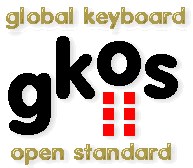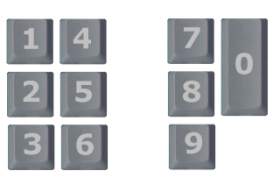The need for a more usable interface on mobile phones became obvious during years 1995 to 2000 while being an active user of GSM text messaging. The basic multitap method, even though painfully slow (9...15 WPM), was best suited for my needs as a compact and precise enough method. In 2004, I frequently switched between T9 and multi-tap within the same message depending on the word to be typed next. Then, after 9 years of active SMSing, you could often guess whether T9 can guess what you intend to express. But still, quite often you bump into words and forms of words that must be re-typed after turning T9 off.
The GKOS Keyboard HistoryIn winter 1999/2000, the idea of combining the pointer control, large display and keyboard was born: "Split the mouse functions between two hands an put a split keyboard onto the back panel where you normally have most of your fingers while holding a wide screen shaped terminal in your hands."
During the year 2000, the method was developed to the extend of having the first prototype keyboard for testing. It was decided to publish this method instead of just having one more proprietary method on the market, and to enable manufactures of mobile phones to apply the same method in their terminals for the benefit of the end user.
On October the 5th, 2000, the GKOS became public domain and was actively presented to mobile manufacturers globally. A web site was also established at http://seppo.n3.net. A test software for attaching the 6-key set to a PC to test the method in practice was also put on the website. The www.gkos.com pages were started in spring 2002.
Some adjustment of the character set was made during 2000-2002.
Since April 2002, there has been a dedicated website at gkos.net for GKOS building projects based on the popular PIC microcontroller 16F876.
In May 2002, the GKOS concept was presented (the document) at the ITU-R WP8F (IMT-2000 and beyond) international working group and the need to have an open common physical keyboard standard for small wireless terminals was emphasized. It was then (16 Oct 2003) approved by WP8F to be fully presented in the final report describing several potential new technologies for IMT-2000 systems and beyond.
During 2003 subjective studies and experiments were made to increase the maximum achievable typing speed from the existing practical limit of 300 chars/min (60 WPM) to an even higher value (80+ WPM) by introducing an enhanced method of detecting sequencies of key depressions. This work resulted in the definition of Chordons (chord chains) and Word Shortcuts (a kind of compatible GKOS shorthand).
In 2004, I was still convinced that if I could choose between the typing methods available for the commercial mobile terminals then, and the GKOS, my choice would be the latter. This is true of course while keeping in mind that I once studied and learned the GKOS method well (45... 50 WPM). Even real-time text communication (like chat) would then be practical with small mobile devices.
In spring 2009, when the iPhone had been there a while, a proposal at the Google GKOS discussion group was presented to make GKOS available as an application utilizing the multi-touch screen (May 25, 2009). The first version of this 'GKOS for Thumbs' was then developed and finally tested during the beginning of 2010. It was made freely available at the iPhone App Store on May 8th, 2010. A demo video for Youtube was also prepared during May 2010 showing how easily text entry speeds of the order 40 wpm can be achieved with it.
On March 24th, 2010, a Gkos library for the popular open source microcontroller board Arduino (Atmel) became available, including also a demo video on Youtube. A GKOS chording keyboard application for Android was started on June 2010 and made available in Android Market on October 3, 2010 (500 downloads on 17 October).
The optimised GKOS Letter Frequency Layout option was presented on 10 July 2011 (Android version). The modified order of letters puts the most common letters on single keys (no chording required) and introduces frequent alternating left/right key presses speeding up typing considerably. Still the difference is kept as small as possible to the original alphabetical layout, enabling the use of the obtained typing skill as much as possible.

Figure: A virtual keyboard that can be operated by the six GKOS keys on the back of the device.Seppo Tiainen 7.6.2002 - email gkos@gkos.com
Updated 3.9.2002, 22.5.2003, 6.11.2003, 4.12.2003, 17.7.2004, 2007, 28 May 2010 and 18 Oct 2010, 24 July 2011.

